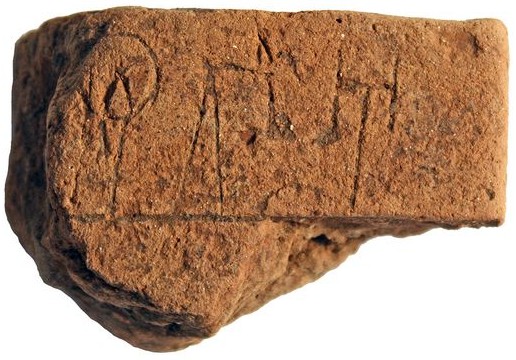Archaeologists excavating a palace thought to be one of King Nestor’s in Iklaina, Greece have discovered a clay tablet inscribed with Linear B characters. They weren’t expecting to find any writing at all on the site, and they certainly didn’t expect to find writing that is 3,350 years old, 150 years older than any other found in Europe.
Excavations at the site have been ongoing for 11 years. Researchers have found an elaborate palace decorated with murals and featuring a clay pipe drainage system that was very advanced for the period. The tablet was discovered last summer.
The tablet measures 2 inches by 3 inches and has writing on both sides in the Linear B system, which is older than the alphabet. It consists of about 87 signs and was used primarily for keeping track of property. On the front of the tablet is a verb that relates to some sort of manufacturing. On the back are what appear to be men’s names alongside numbers.

Because they were made out of brittle sun-baked clay and kept only for the duration of the fiscal year, usually tablets fell apart and were recycled after a year of use. This tablet survived because someone threw it in a garbage pit which later caught fire, thus inadvertently firing the clay.
It’s also surprising to find a writing tablet on a site not considered to be a major ruling center of the Mycenean period. Writing from this era so far has been found only on sites of prominent political importance, because the Mycenaeans appear to have used Linear B writing only to record economic matters of the ruling elites.
Iklaina was an independent city-state until it was conquered by King Nestor in 1400 BC. He absorbed it into his kingdom, but it wasn’t his ruling capital, just a secondary district capital. Another of Nestor’s conquered city-states, Nichoria, was in a similar political position and researchers found no writing there. The discovery of the tablet, a formal government record from a formative period in the state’s ruling history, might provide valuable information about governmental administration in the Mycenean era.
The presence of the tablet at Iklaina, Palaima said, suggests two possibilities. It may indicate that Iklaina was once a major center of its own and had the potential to become a dominant center until it was crushed and absorbed by Pylos.
But it could also be that, even after Iklaina became part of Nestor’s kingdom, it was allowed to retain a significant amount of administrative freedom. That would be surprising, Palaima said, because most historians believe that virtually all record-keeping was centralized in the major centers. If the city was allowed to retain record-keeping, it would suggest that Pylos maintained a benevolent rule over its domain.
Reading and writing were restricted to the wealthy elites. It was generally considered a magical art, and would retain its mystique until the Greek alphabet of 26 letters overtook Linear B 400 to 600 years after this tablet was carved.
Tidbits like this and the Antikythera Mechanism make you wonder about what else has been lost to the ages. This sort of material, graciously brought to our attention in this blog, provides us with an endless source of fascination.